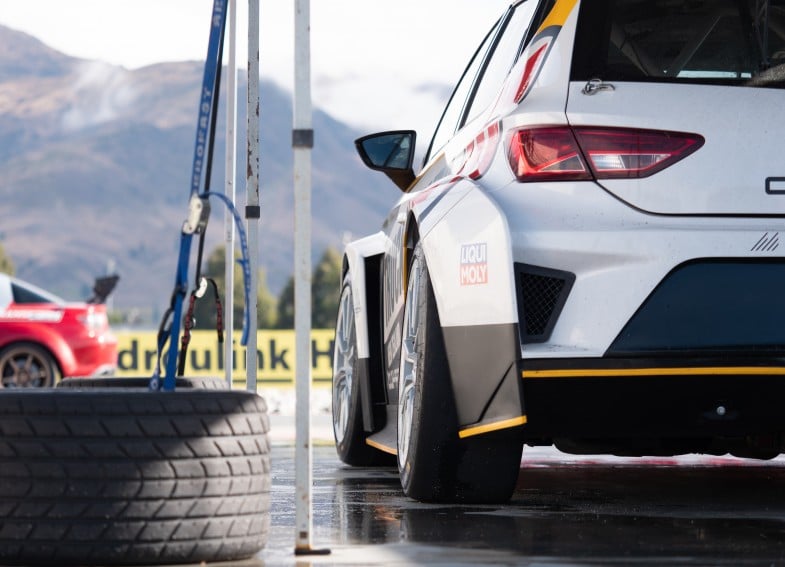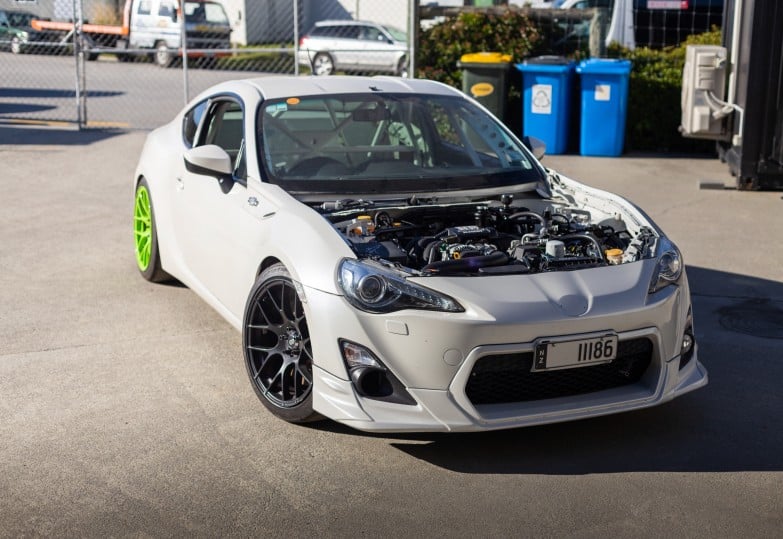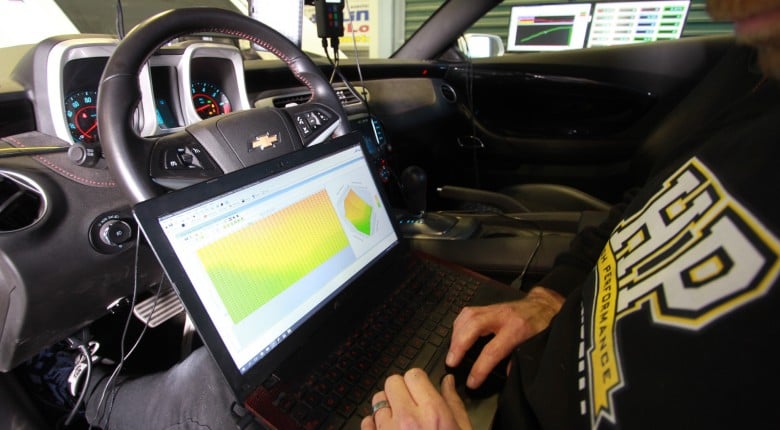When it comes to actually tuning an engine, we’ve got some choices available and since nothing in life is ever easy, each has its own pros and cons. So that you can make an educated decision about what is best for your car, I’ve written this article to guide you through the options so you can sort fact from fiction. Broadly speaking, our tuning options can be broken down into three main areas - Dyno tuning, Road Tuning and E-Tuning (aka mail-order tunes).
Before we start though, it’s important to understand what we are trying to achieve when tuning an engine, and what we need to be able to get the best results. When we break it down to basics, tuning an engine really comes down to optimising the fuel delivery and the ignition advance. Of course, there is potentially a lot more going on in a modern engine with aspects such as VVT, E-throttle and boost control to consider, but the basic elements we need to optimise are still fuel and ignition.
To do our job then we need three elements - A way of accurately measuring the air fuel ratio, a way of monitoring for knock or detonation, and some feedback to tell us how our tuning changes are affecting the torque the engine is producing. Now that we know what elements we need, let’s go through our options.
In this article: Dyno Tuning | Road Tuning | E-Tunes | Conclusion
Dyno Tuning
When we think of tuning, most people immediately think of a dyno and when we have the option to tune on a dyno, this is usually going to give you the best possible results. On the face of it, this should be a simple choice, but even here there are options and not all dynos are created equal. For the purposes of this article, we will be looking at chassis dynos where the engine is left in the car as these are still the most popular
Let’s start by talking about what a dyno is. In a nutshell, the dyno is used to apply a load to the engine to replicate driving the car on the road. As well as being able to apply a load to the engine, the dyno will also be able to measure the torque being produced and from this, the engine power can be calculated. Depending on how smart or advanced the dyno is, it will also be able to log parameters such as boost pressure and air fuel ratio and provide the tuner with torque and power graphs that can be analysed after a run. From here we can make decisions on what elements in our tune to adjust.
The advantage here to the tuner is that the dyno can provide instant and accurate feedback about the progress of their tune. A good dyno should be sensitive enough to show very small changes in torque, like the difference caused by alternator draw when the headlights switch on and off. This makes it easy to tell if we are going the right way with our tuning, and a proper load bearing dyno is essential to correctly calibrate elements such as ignition timing and cam control.
I’ve just mentioned the term ‘load bearing’, and that deserves a little more explanation. There are two main classes of chassis dyno - Inertia dynos and load bearing dynos. An inertia dyno is simply a drum or roller of a large and known mass. There is no power absorber module associated with these dynos and hence if you put your foot down on the throttle, the engine will accelerate. The dyno calculates engine power based on the mass of the roller and the rate of acceleration. These inertia dynos can’t apply a variable load to the engine and hence it’s difficult or impossible to operate the engine at a fixed rpm. Inertia dynos, however, are cheaper to manufacture and can do an adequate job if you only want to test the engine at full throttle.
A load bearing dyno, on the other hand, will have some form of power absorber module (hydraulic, eddy current or water brake are all popular techniques) that will allow the dyno to vary the load applied to the engine to hold the rpm constant. This is the sort of dyno we really need to be using for proper tuning as it will allow us to vary both the rpm and load to tune all of the sites in the fuel and ignition tables correctly.
Pros
- Provide accurate feedback on any tuning changes made
- Essential for properly mapping advanced engines with VVT
- Essential to properly calibrate ignition timing
- Allows tuner to concentrate solely on tuning the engine
- Fast and safe
Cons
- Access can be difficult in some countries or cities
- Purchasing a dyno or even renting dyno time can be costly
- It’s difficult to adequately replicate the cooling airflow you would expect to see on the road
Road Tuning
When I discuss tuning an engine on the road I get mixed results, with most professional tuners very vocal in their dislike for the idea. With dynos being so common these days, most people consider road tuning to be irrelevant or dangerous and certainly, the result must be sub-standard. On the face of it, this seems reasonable and certainly, road tuning can be dangerous if not approached sensibly, but it can also provide exceptional results in many circumstances. I’m not saying that road tuning is a suitable replacement for a dyno, and there are some complexities and compromises involved with this tuning technique. Sometimes though, you may have no option but to tune on the road and I believe it’s a skill every tuner should have.
It may sound surprising but there are also some real advantages to road tuning that are often overlooked. For example unlike on the dyno where engine bay airflow, inlet temperature and airflow into the airbox may differ dramatically from what we see on the road. When road tuning we are actually tuning the engine in the exact conditions it will operate in. This is actually one of the reasons I’m a strong advocate of always confirming any tune on the road once a car has come off the dyno.
The first obvious downside of road tuning is that we have no feedback on the result of our tuning changes. I don’t care how well calibrated your ‘butt dyno’ is, nobody is going to be able to tell if an extra degree of ignition advance at 4750 rpm gained or lost 3 kW. If you have no option but to tune on the road, you need to accept that there will be some compromises in your tune.
While we don’t have any feedback on torque, in many instances this actually doesn’t make much difference to our ability to optimise the ignition timing. I have found over the course of 15 years and tuning literally thousands of engines, that the majority of engines running on pump gas will actually be knock limited. What this means is that when optimising the ignition timing, we actually reach the knock threshold before we reach MBT (Maximum brake torque) - This is even more prominent if you’re tuning a factory turbocharged engine. In this instance it doesn’t matter if we are tuning on the road or the dyno, the knock threshold will limit our ignition advance and hence the results we can get on the road are generally every bit as good as what we could hope to achieve on the dyno.
Of course, if you are tuning on a good quality fuel such as E85, methanol or C16/Q16 or similar, then chances are you won’t be knock limited. This gets a little trickier as it would be easy to have the timing over advanced which can actually be counter productive. In these situations, we have no option but to rely on a conservative timing map that may be leaving some power on the table or use a dyno to correctly optimise the ignition advance.
There are a number of software packages that will estimate power and torque based on acceleration and vehicle mass but personally I’ve yet to see the sort of sensitivity and repeatability that would make these packages truly useful. If you are going to try one, make sure you use the same stretch of road for your testing. Incline, windspeed and even surface condition can influence your results. Also, make several baseline runs before you make any changes so you can assess the repeatability of the software. If the software can’t give you repeatability within a few percent then it could easily be misleading and counter productive.
Pros
- Cheap or free
- Easy access provided you have a straight stretch of road
- You’re tuning the car in exactly the same conditions it will be used in
- Ability to access the very light load areas of the mapping that can be impossible to reach on a dyno
- Transient or acceleration enrichment tuning is often easier to accomplish on the road than a dyno
Cons
- Safety can be compromised if you are attempting to tune a car while controlling it on a road
- No feedback on the effect of tuning changes
- Local laws may affect your ability to view a laptop while driving
E-Tunes

The internet is an amazing thing and over the last few years, we have seen the rise of ‘E-Tunes’ or mail order tunes being offered by a number of vendors across a range of popular forums. The idea behind an E-Tune is that you provide a tuner (who is hopefully well versed in your particular model) a list of your modifications and he/she will email you a new ROM file that you can upload into your ECU. In some instances, you may need to remove the ECU and actually send it to the tuner for this work to be done. Usually, the initial tune will then be backed up by you performing several logged acceleration runs in 3rd/4th gear and perhaps the original file may be adjusted based on the results of these logs.
The main advantage here is that the internet makes the world very small so those located remotely with no dyno nearby now have options for tuning. With no need to actually run the car on a dyno coupled with the intense competition in this market, this can also end up being a cheap way of getting your car tuned. As you could expect though, results vary widely from fantastic through to failed engines and hence a little more exploration and caution are needed.
When we have a car on the dyno, obviously we can see exactly what’s going on - We are directly monitoring AFR and can listen for knock. This means we have fast, accurate control over the progress of the tune. We are also optimising the tune specifically for the particular engine, any specific modifications performed to it, and the exact fuel you intend to run. Hence on the dyno, we can get the best possible results while ensuring a sufficient safety margin. Without being able to physically see a particular car on the dyno, the only smart option is to provide a somewhat wider safety margin in the tune. This means a little less ignition timing and a slightly richer mixture to provide the necessary safety. With this in mind, an E-Tune will normally not make quite the same power as a custom tune performed live on a dyno.
The other issue comes from what data is available to the tuner. While this is getting better with some late model cars, relying on data logging from the factory AFR sensor (despite being classed as a wideband, many factory wideband sensors are still far from accurate at the sort of AFR we want to run at full power), and knock feedback is marginal at best.
My advice if you are considering getting an E-Tune for your car would be to do your homework. For most popular cars there will be a handful of tuners who are offering E-Tunes. Talk to some of their customers and find out what sort of results and reliability they got from their tune before spending your money. Remember when you are doing this research that every tuner has raving fans and sworn enemies and there are two sides to every story. By the time you have talked to 2-3 customers though you should be able to get a good picture of what sort of results you can expect.
Pros
- Low cost
- No need to travel
Cons
- Unlikely to offer the ultimate power your package is capable of
- Results can vary dramatically
- Homework is required to make sure you deal with a reputable tuner prepared to back their workmanship
Conclusion

As with most aspects of automotive performance, there are many ways of achieving your particular aims. Some are better than others and all have their pros and cons. There is no ‘right’ answer though as the best option for one person may be impossible for another. The aim of this article was to educate you about the options that exist and what their pros and cons are. With this knowledge, I hope you will be able to make a better informed decision about how to approach your next tuning job.






